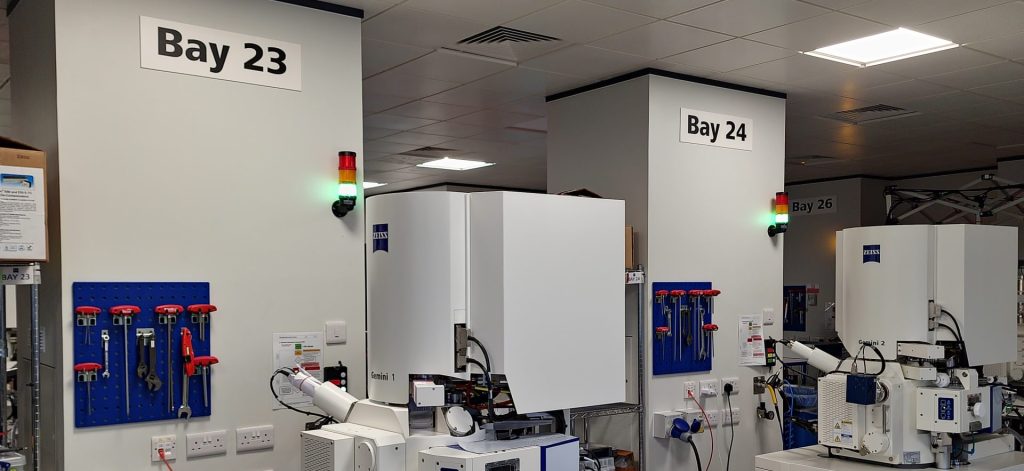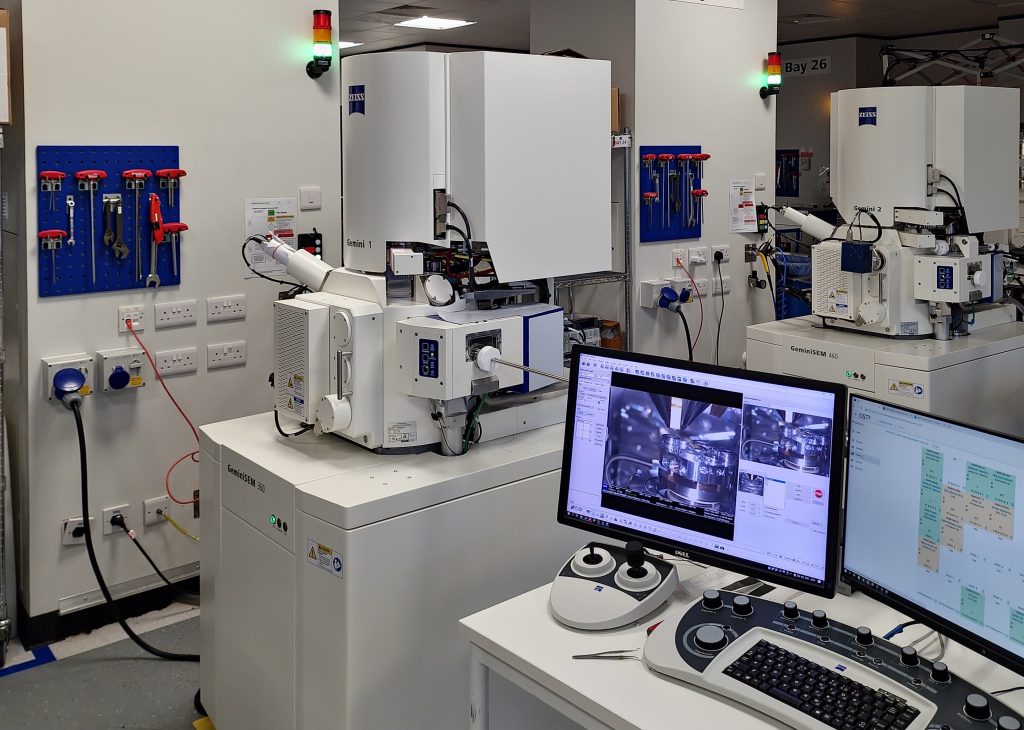Light stalk automation

A research pilot with Carl Zeiss reveals how Shoestring can inspire employees to improve systems using low-cost prototypes, and how a Shoestring demonstrator could be adapted to meet industrial requirements.
Keen to understand how a company could develop a Shoestring solution so that it met an industrial specification and incorporated security measures, the Shoestring research team from the Institute for Manufacturing, part of the University of Cambridge, collaborated with a group of engineers at Carl Zeiss Microscopy. The Continuous Improvement Engineer, Process Engineering Manager and Final Test Manager at Zeiss were looking for a way to improve the functioning of their final test bays during the quality check and testing process of their electron microscope. However when they turned to their usual supplier, the cost was prohibitively expensive. Shoestring helped open up a new avenue which they hadn’t considered before, to develop a solution using low-cost components.
Shoestring has played a key role in reshaping our approach towards seeking innovative solutions. It has broadened our perspective and made us aware of the untapped potential found in developing cost-effective solutions in production instead of buying off-the-shelf expensive equipment. As a result, the collaboration between IfM and Zeiss has greatly contributed to our progress in achieving continuous improvement.”
Tim Kitchener, Continuous Improvement Engineer, Carl Zeiss Microscopy Ltd
The business challenge
Zeiss tests all its Scanning electron microscopes at the company’s Cambourne site in the UK. As all of these expensive and precise scanning electron microscopes are built to the individual customers’ specification, they are each assigned their own testing and calibration schedule. This work takes place across 47 workstations. Operators working in the bays were required to update their job status on two systems – manually activate a job status light on the bay’s light stalk and update the same status and location of the product on the computer. There were often mismatches between the computer report and what was in the bay, so the Final Test Manager wanted to unify the system so that operators only performed one single action to update the status on the MES system and the light stalk to mirror it. To link the light stalk status with the computer system would cost over £20,000 using their supplier so Zeiss turned to Shoestring to find out if there was a lower cost alternative.

The pilot presented the Shoestring research team with two challenges. Firstly, to create the first Shoestring solution that incorporated an actuation service module. In this case by updating the MES system an actuation was sent to the light stalk to make it change colour in accordance with the latest update. Secondly to see if a company could learn from the Shoestring demonstrator and, using similar code and design, build their own industrial version that incorporated security measures.
The solution
Shoestring built a demonstrator which illustrated how a command input on the MES system could wirelessly trigger relays. These relays control the lights and change the status on the light stalk (i.e. the light colour) and update the records in the database. Using the Shoestring demonstrator as a prototype, the Zeiss team, with support from Shoestring, built their own version of the solution using a microcontroller and relay board (built together) and a wireless interface. They used MQTT for communication (they integrated it into their own system and database) and installed a separate wireless network to enable this system across all 47 workstations.
The outcomes
With support from Shoestring the Zeiss team was able to mass produce their own industrial version of the solution that complied with their security protocols and could be installed in every bay for about £25 per bay, costing approximately £1200 for all 47 workstations. The solution solved the challenge, saving the Final Test Manager’s time by giving a clear visual status of all of production in real time.
The exercise also gave the Zeiss team a new way to continuously improve their processes. They learnt that you can use low-cost components in an industrial environment and build something that is brand agnostic, freeing them to choose new suppliers. If they had bought a commercial OEM solution to solve this problem it would have cost about £625 per lightstalk, costing approximately 30 times more and, in addition, they would missed out on the continuous improvement learning from which staff benefitted.
Next steps
With the inspiration from the Shoestring project, and the secure wireless infrastructure now set up in production, we are now looking at how we can utilise this further. One possible option is to gather live environmental data from around production, e.g temperature, humidity and acoustic noise.“
Tim Kitchener, Continuous Improvement Engineer, Carl Zeiss Microscopy Ltd
Case study summary: Carl Zeiss Microscopy
Solution setup:
- Solution: light stalk automation
- Deployed: across 47 workstations on one production floor
- Technology used: Shelly RGBW2
- Technology cost: approximately £25 per station (£1200 across 47 bays)
- Time taken to deploy: approximately 3 months for initial demonstrator, a further 2 months for the Zeiss team (with Shoestring support) to rollout across the production floor
Key outcomes:
- Saves management time approximately 8 hours a week (equating to approx £480 cost saving)
- Improved visual management as the real status is displayed and it’s connected to the live system, giving 100% accurate status
- Introduced new digital and procurement skills to employees
- Introduced a new low-cost angle to the continuous improvement scheme
- Preparing staff for introduction of further systems, like a new ERP system to track all inventory across the site
Next steps:
- Considering their options – possible option is to gather live environmental data from around production (e.g. temperature, humidity and acoustic noise)
FIND OUT MORE
Shoestring’s inventive approach helps small and medium sized manufacturers take the first steps to digitalisation by using off-the-shelf technology to create practical low-cost, low risk digital solutions.
Find out how Shoestring could help your company embrace digitalisation
CONTACT US